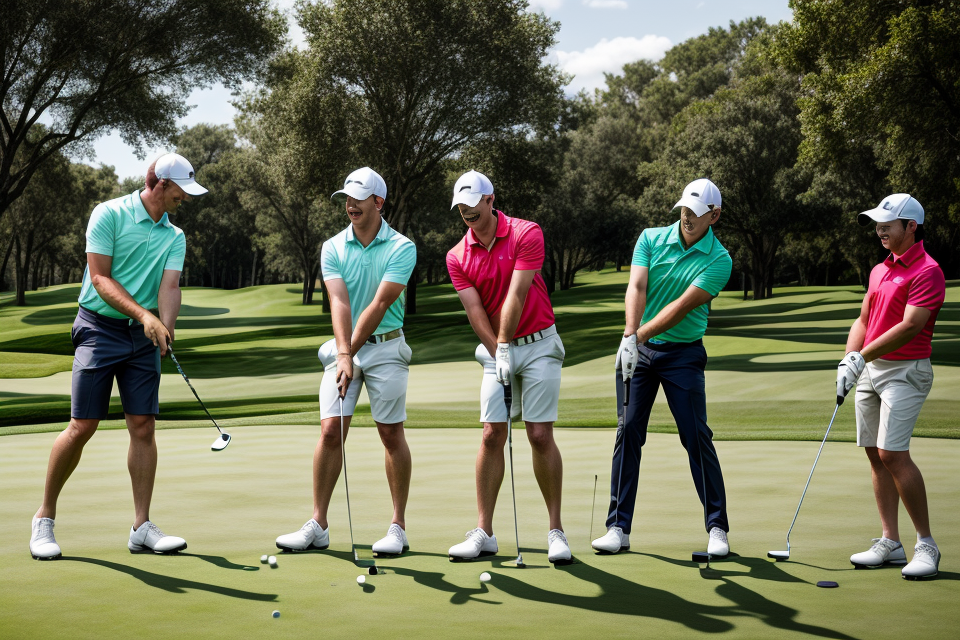
Golf is a sport that demands precision, patience, and practice. However, not everyone is cut out for it, and some may even be considered “bad” at it. But what does that really mean? In this article, we will explore the myths surrounding the label of a “bad” golf player and delve into the different aspects of the game that contribute to one’s skill level. Whether you’re a seasoned pro or a beginner, this article will provide valuable insights into the world of golf and dispel common misconceptions about what it means to be a “bad” golfer. So, grab your clubs and let’s tee off into the world of golf!
The term “hacker” is often used to refer to a bad golf player, but this moniker is not an official one and is more of a derogatory term used by some in the golfing community. The term “duffer” is another colloquialism that is sometimes used to describe a poor golfer, but this term is not as widely recognized or used as “hacker.” Ultimately, it’s important to remember that golf is a sport that requires practice and patience, and that everyone starts somewhere. Rather than using derogatory terms, it’s more productive to offer support and encouragement to those who are learning the game.
The Common Perception of a Bad Golf Player
Labeling and Stigmatization
The Term “Hacker” and Its Negative Connotations
The term “hacker” has been used to describe individuals who are perceived to have a poor grasp of the game, and it carries with it a set of negative connotations. The word “hacker” originated from the term “hacking,” which referred to a player who played the game in an unconventional manner, often resorting to shortcuts or “hacks” to improve their performance. Over time, the term “hacker” became associated with a lack of skill and a poor understanding of the game.
The Impact of Being Labeled as a Bad Golfer
Being labeled as a bad golfer can have a significant impact on an individual’s self-esteem and confidence. The negative connotations associated with the term “hacker” can lead to feelings of embarrassment, frustration, and discouragement, causing some individuals to avoid playing the game altogether. Furthermore, the label can follow an individual throughout their golfing career, affecting their interactions with other players and impacting their ability to find playing partners.
Moreover, the labeling and stigmatization of bad golf players can perpetuate a cycle of inexperience and lack of knowledge within the sport. New golfers, in particular, may be hesitant to ask for help or guidance for fear of being labeled as a “hacker.” This reluctance to seek assistance can lead to a lack of development and improvement, further entrenching the perception of bad golf players as inferior or incompetent.
It is essential to recognize that the negative connotations associated with the term “hacker” are largely based on subjective perceptions and personal biases. By examining the root of these perceptions and challenging the prevailing assumptions, we can work towards a more inclusive and supportive environment for all golfers, regardless of their skill level.
Factors Contributing to the Perception
Misconceptions about golf
Golf is often perceived as a sport that requires a certain level of physical prowess and athleticism. This notion is far from the truth, as golf is primarily a game of precision and accuracy, requiring skill and strategy.
Unrealistic expectations
Another factor contributing to the perception of a bad golf player is unrealistic expectations. Many people believe that they should be able to play golf at a high level after just a few lessons or rounds on the course. However, golf is a complex sport that requires a significant amount of time and practice to master.
Inability to understand the learning curve
Lastly, many people simply do not understand the learning curve that is inherent in golf. Just like any other sport or activity, golf requires a significant amount of time and effort to improve. There are no shortcuts or easy ways to become a skilled golfer, and it is important to recognize that progress will be slow and steady.
Redefining the Narrative: Alternative Perspectives
Embracing the Learning Process
The act of playing golf is not just about achieving perfection, but also about embracing the learning process. By doing so, one can enjoy the journey of improving their skills and become a better golfer.
The Importance of Enjoying the Journey
Golf is a sport that requires patience, persistence, and dedication. It is not about reaching a certain level of skill in a short amount of time, but rather about enjoying the process of learning and improving over time. By focusing on the journey rather than the end result, golfers can develop a greater appreciation for the sport and the challenges it presents.
Understanding that Progress Takes Time
Improving one’s golf game is a gradual process that takes time and effort. It is important to understand that progress may not always be linear and that setbacks are a natural part of the learning process. By adopting a growth mindset and embracing the learning process, golfers can develop a greater sense of resilience and perseverance, which are essential qualities for success in any pursuit.
Additionally, by focusing on the process rather than the outcome, golfers can develop a greater sense of satisfaction and fulfillment from their efforts. They can take pride in their progress, even if they do not achieve immediate success, and continue to work towards their goals with a positive attitude.
Recognizing Personal Achievements
- Celebrating small victories
- Appreciating individual improvements
Celebrating Small Victories
- Embracing the journey of improvement
- Fostering a growth mindset
- Encouraging self-congratulation
Golf is a sport that demands precision, patience, and persistence. While it is true that a player’s performance can be measured by their scores, it is equally important to recognize the personal achievements that come with each step of the journey. Celebrating small victories is an essential aspect of this process, as it fosters a growth mindset and encourages self-congratulation.
When a golfer improves their swing, reduces their handicap, or simply hits a great shot, it is essential to acknowledge these accomplishments. Celebrating small victories not only provides a sense of satisfaction but also motivates the golfer to continue working towards their goals.
In addition, embracing the journey of improvement is crucial for fostering a growth mindset. By recognizing the effort and dedication required to improve, golfers can develop a greater appreciation for the sport and their own abilities. This mindset can help players maintain a positive attitude, even in the face of challenges or setbacks.
Moreover, celebrating small victories encourages self-congratulation, which is a crucial aspect of personal growth and development. By acknowledging their achievements, golfers can build confidence and develop a stronger sense of self-worth. This confidence can translate into improved performance on the course, as players become more self-assured and less intimidated by the challenges of the game.
Appreciating Individual Improvements
- Recognizing incremental progress
- Fostering a sense of accomplishment
- Encouraging continued growth
Another way to recognize personal achievements in golf is by appreciating individual improvements. This can include everything from improving one’s driving distance to reducing the number of putts per hole. By recognizing these incremental improvements, golfers can develop a greater sense of accomplishment and pride in their progress.
Appreciating individual improvements is essential for maintaining motivation and focus. When golfers see tangible evidence of their progress, they are more likely to continue working towards their goals. This sense of accomplishment can also help players maintain a positive attitude, even when faced with setbacks or challenges.
Furthermore, appreciating individual improvements encourages continued growth and development. By recognizing the progress they have made, golfers can identify areas for further improvement and set new goals. This approach fosters a sense of purpose and direction, which is essential for continued growth and success in the sport.
In conclusion, recognizing personal achievements is a crucial aspect of redefining the narrative around what it means to be a bad golfer. By celebrating small victories and appreciating individual improvements, golfers can develop a greater sense of satisfaction, motivation, and confidence. This shift in perspective can help players of all skill levels find joy and fulfillment in the sport, while also fostering a growth mindset and encouraging continued improvement.
Encouraging Growth and Development
In the world of golf, there is often a focus on achieving perfection and reaching the pinnacle of skill. However, it is important to remember that every golfer starts somewhere, and that the journey towards improvement is just as valuable as the end result. In this section, we will explore the ways in which we can encourage growth and development in golf players, regardless of their current skill level.
Fostering a supportive community
One of the most effective ways to encourage growth and development in golf players is to create a supportive community. This can include:
- Building relationships with fellow golfers, who can offer encouragement and advice
- Creating a sense of camaraderie and shared purpose among players
- Providing opportunities for players to connect with coaches and mentors who can offer guidance and support
By fostering a supportive community, golf players are more likely to feel motivated and engaged in their journey towards improvement. They will also have access to a network of resources and expertise that can help them to overcome challenges and reach their goals.
Offering constructive feedback
Another key aspect of encouraging growth and development in golf players is to provide constructive feedback. This can include:
- Identifying specific areas for improvement and providing actionable steps for players to work on
- Highlighting strengths and areas of success, in order to build confidence and reinforce positive behaviors
- Providing ongoing support and guidance as players work to improve their skills
By offering constructive feedback, coaches and mentors can help players to identify areas for improvement and develop a roadmap for growth. This can be especially valuable for players who may be struggling or feeling discouraged, as it helps to provide a clear path forward and a sense of direction.
Overall, by fostering a supportive community and offering constructive feedback, we can create an environment that encourages growth and development in golf players of all skill levels. This will help to promote a positive and inclusive culture in the sport, and ensure that all players have the opportunity to reach their full potential.
Debunking Myths and Misconceptions
Skill vs. Talent
Golf is often perceived as a game that requires a natural talent, with those who possess it excelling on the course. However, this belief is a myth that overlooks the critical role of practice and persistence in developing golf skills.
The Role of Practice and Persistence
Golf is a complex sport that demands a combination of physical and mental abilities. To become proficient in golf, players must put in hours of practice and repetition to master the various techniques and strategies involved. It is important to note that natural talent alone does not guarantee success in golf. Dedicated practice and perseverance are crucial to improving one’s game.
Furthermore, practice does not just involve hitting balls on the driving range. It also involves analyzing one’s swing and technique through video analysis, seeking feedback from coaches and peers, and working on physical fitness and mental toughness.
The Importance of a Growth Mindset
A growth mindset is a crucial factor in developing golf skills. Individuals with a growth mindset believe that their abilities can be developed through dedication and hard work. They view challenges as opportunities for growth and learning, rather than as threats to their ego or self-worth.
In contrast, those with a fixed mindset believe that their abilities are innate and cannot be changed. They may give up easily when faced with difficulties or setbacks, as they view these as evidence of their lack of talent.
Having a growth mindset can help golfers persist in the face of challenges and continue to work towards improvement, even in the face of setbacks. It also fosters a positive attitude towards learning and self-improvement, which is essential for long-term success in golf.
In conclusion, the myth that golf requires natural talent overlooks the critical role of practice and persistence in developing golf skills. By dedicating themselves to regular practice and adopting a growth mindset, golfers can improve their skills and achieve success on the course.
The Four Basic Swing Types
When it comes to golf swings, there are four basic types that every player can be classified into. These types are determined by the player’s physical characteristics, such as their height, arm length, and shoulder turn. Understanding these swing types can help golfers to identify their natural swing and adapt their technique accordingly.
- Dual Plane Swing
The dual plane swing is characterized by a shoulder turn that moves on two separate planes. This type of swing is typically used by players who are taller and have longer arms. - Single Plane Swing
The single plane swing involves a shoulder turn that moves on a single plane. This type of swing is often used by players who are shorter and have shorter arms. - Stack and Tilt Swing
The stack and tilt swing is characterized by a shallow shoulder turn and a tilted spine. This type of swing is commonly used by players who are taller and have longer arms. - Classic Swing
The classic swing is characterized by a traditional shoulder turn and a vertical spine. This type of swing is often used by players who are shorter and have shorter arms.
By understanding the four basic swing types, golfers can better identify their natural swing and make the necessary adjustments to improve their game. It is important to note that every golfer is unique and may not fit perfectly into one of these categories. However, identifying one’s swing type can be a helpful starting point for improving one’s golf game.
Strategies for Improving Your Golf Game
Developing a Holistic Approach
When it comes to improving your golf game, a holistic approach is key. This means that instead of focusing solely on one aspect of your game, you should aim to improve all three areas: physical, mental, and strategic. By doing so, you’ll be able to develop a well-rounded game that is less likely to suffer from the common pitfalls that plague many golfers.
Here are some ways to incorporate a holistic approach into your game:
- Physical Aspects: This includes factors such as your swing mechanics, strength, flexibility, and overall physical fitness. To improve your physical game, you should consider working with a golf pro to identify any swing flaws, and then incorporate exercises that will help you build the necessary strength and flexibility to correct those flaws.
- Mental Aspects: Golf is just as much a mental game as it is a physical one. To improve your mental game, you should focus on developing your mental toughness, resilience, and concentration. This can be done through visualization exercises, mindfulness practices, and cognitive-behavioral therapy techniques.
- Strategic Aspects: Strategy is another crucial aspect of golf. To improve your strategic game, you should spend time studying the course, identifying the best routes to the green, and developing a pre-shot routine that will help you make more informed decisions on the course.
One useful tool for improving your game is video analysis. By recording your swings and then reviewing them with a golf pro, you can identify any flaws in your technique and develop a plan to correct them. Additionally, feedback from your playing partners or golf instructors can be incredibly valuable in helping you identify areas for improvement.
In conclusion, by taking a holistic approach to improving your golf game, you’ll be able to develop a well-rounded game that is less likely to suffer from the common pitfalls that plague many golfers.
Prioritizing Fundamentals
Mastering the basics is essential for any aspiring golfer looking to improve their game. It is a common misconception that focusing solely on the fundamentals will hinder progress, but in reality, it is the foundation upon which all advanced techniques are built.
Incorporating drills for consistency is crucial in developing a solid golf game. Consistency is key in golf, and incorporating drills that target specific aspects of the game, such as grip, stance, and swing, can help build muscle memory and improve overall performance.
It is important to note that improving one’s golf game is a gradual process that requires patience and dedication. By prioritizing fundamentals, golfers can establish a strong foundation upon which to build their skills and ultimately become better players.
Building Resilience and Adaptability
Overcoming obstacles and setbacks
As a golfer, it is inevitable that you will encounter obstacles and setbacks along the way. However, instead of letting these challenges discourage you, use them as opportunities to learn and grow. Analyze your performance, identify the areas where you struggled, and work on improving those specific skills. By doing so, you will become more resilient and better equipped to handle difficult situations on the course.
Adjusting to different courses and conditions
Golf courses can vary greatly in terms of design, layout, and weather conditions. To become a better golfer, it is essential to learn how to adapt to different courses and conditions. This includes understanding how to adjust your strategy based on the layout of the course, choosing the right equipment for the weather conditions, and learning how to manage your emotions in response to the ever-changing circumstances on the course. By developing the ability to adapt, you will be better prepared to handle any situation that arises on the golf course.
Seeking Professional Guidance
One of the most effective ways to improve your golf game is by seeking professional guidance. Working with a golf coach or instructor can help you identify and correct flaws in your swing, stance, and overall technique. Here are some strategies for seeking professional guidance:
-
Working with a golf coach or instructor
- Finding the right coach or instructor
- Researching and selecting a coach or instructor with experience and expertise in your specific area of need
- Considering factors such as coaching style, personality, and availability
- Setting goals and expectations
- Discussing your goals and expectations with your coach or instructor
- Establishing a timeline and measurable objectives for improvement
- Developing a customized training program
- Receiving personalized instruction and feedback
- Implementing drills and exercises tailored to your needs
- Regular practice and feedback sessions
- Scheduling regular practice sessions with your coach or instructor
- Receiving ongoing feedback and adjustments to your technique
- Maintaining a positive and focused mindset
- Staying motivated and committed to your goals
- Remaining open to constructive criticism and adjustments to your game.
- Finding the right coach or instructor
-
Utilizing technology to enhance your game
- Golf simulators and launch monitors
- Using technology to practice and analyze your swing and ball flight
- Receiving data-driven feedback and insights
- Swing analysis software
- Analyzing your swing using motion capture technology
- Identifying areas for improvement and tracking progress
- Mobile apps and golf training aids
- Using apps and training aids to practice and reinforce proper technique
- Incorporating technology into your practice routine to enhance your game.
- Golf simulators and launch monitors
FAQs
1. What is the common term used to refer to a bad golf player?
The common term used to refer to a bad golf player is a “hacker.”
2. Why is the term “hacker” used to describe a bad golfer?
The term “hacker” is used to describe a bad golfer because they often hit the golf ball in a choppy or uncontrolled manner, similar to how a hacker would attempt to break into a computer system.
3. Are there any other terms used to describe a bad golfer?
Yes, there are several other terms used to describe a bad golfer, including “slicer,” “duffer,” “mulligan,” and “hack.”
4. What is the origin of the term “hacker”?
The term “hacker” originated in the 1960s and was used to describe someone who played golf with a lot of effort and little success. It eventually became a term used to describe someone who plays golf poorly.
5. Is there a gender-specific term for a bad golfer?
There is no specific gender-based term for a bad golfer. The terms “hacker,” “slicer,” “duffer,” “mulligan,” and “hack” are commonly used regardless of gender.


